Discover 6 hidden attractions, cool sights, and unusual things to do in Axum (Ethiopia). Don't miss out on these must-see attractions: Church of Our Lady Mary of Zion, Dungur, and Ezana Stone. Also, be sure to include Obelisk of Axum in your itinerary.
Below, you can find the list of the most amazing places you should visit in Axum (Tigray).
Table of Contents
Church of Our Lady Mary of Zion
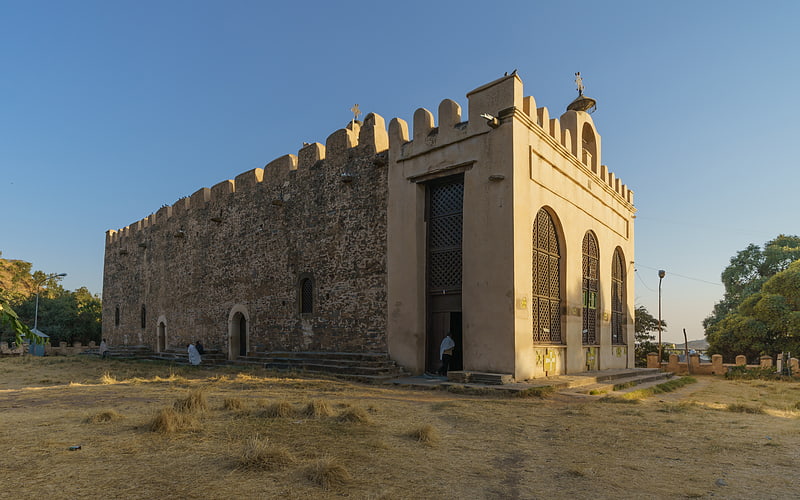
Also known as: አክሱም ጽዮን
Church in Axum, Ethiopia. The Church of Our Lady Mary of Zion is an Ethiopian Orthodox Tewahedo Church which is claimed to contain the Ark of the Covenant.
The church is located in the town of Axum, Tigray Region in northern Ethiopia, near the grounds of Obelisks of Axum. The original church is believed to have been built during the reign of Ezana the first Christian ruler of the Kingdom of Axum (Present-day Eritrea and Ethiopia), during the 4th century AD, and has been rebuilt several times since then.
Today, the site contains the Old Church rebuilt in the 16th century, the New Cathedral built by the Emperor Haile Selassie in 1950s, as well as a chapel that said to house the Ark of the Covenant.[1]
Dungur
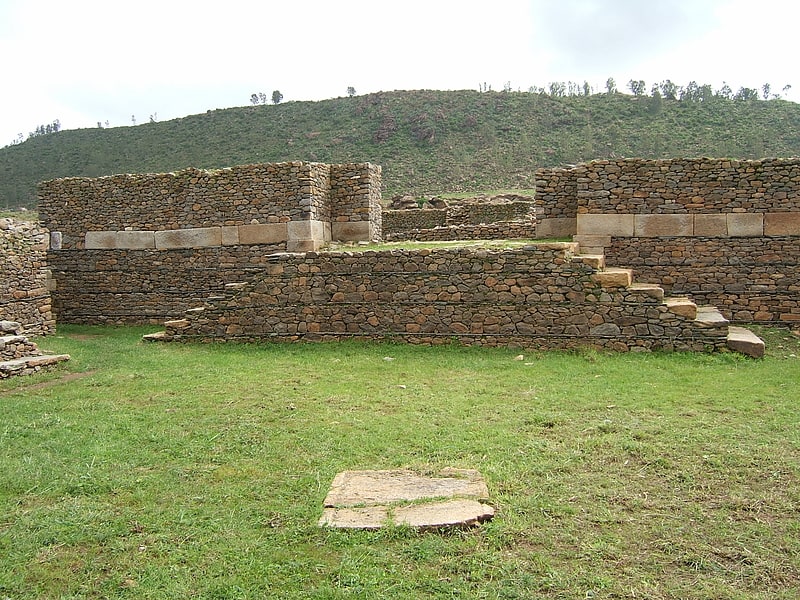
Archaeological site in Axum, Ethiopia. Dungur is the ruins of a substantial mansion in Aksum, Ethiopia, the former capital city of the Kingdom of Aksum. The ruins are in the western part of Aksum, across the road from the Gudit stelae field.
Dungur is known locally and popularly as the Palace of the Queen of Sheba (i.e. the Palace of Makeda in Ethiopia).[2]
Ezana Stone
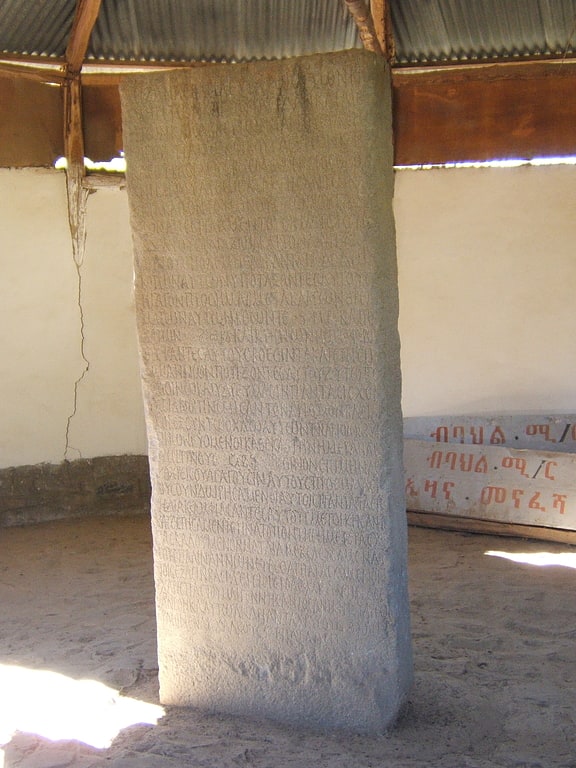
Historical landmark in Axum, Ethiopia. The Ezana Stone is an ancient stele still standing in modern day Axum, the centre of the ancient Kingdom of Aksum. This stone monument, that probably dates from the 4th century of the Christian era, documents the conversion of King Ezana to Christianity and his conquest of various neighbouring areas, including Meroë.
From AD 330 to 356, King Ezana ruled the ancient Kingdom of Aksum centred in the Horn of Africa. He fought against the Nubians, and commemorated his victories on stone tablets in praise of God. These liturgical epigraphs were written in various ancient languages, including the Ethiopian Semitic Ge'ez, the South Arabian Sabaean, and Greek. The king's engravings in stone provided a trilingual monument in different languages, similar to the Rosetta stone.
The Ethiopian Orthodox Tewahedo Church had its beginnings during this period. Rufinus's Ecclesiastical History narrates that Saint Frumentius, a freed slave and tutor for the very young King, converted him to Christianity. Towards the end of his reign, King Ezana launched a campaign against the Kushites around 350 which brought down the Kingdom of Kush. Various stone inscriptions written in Ge'ez (using the Ge'ez script) have been found at Meroë, the central city of the Kushites.[3]
Obelisk of Axum
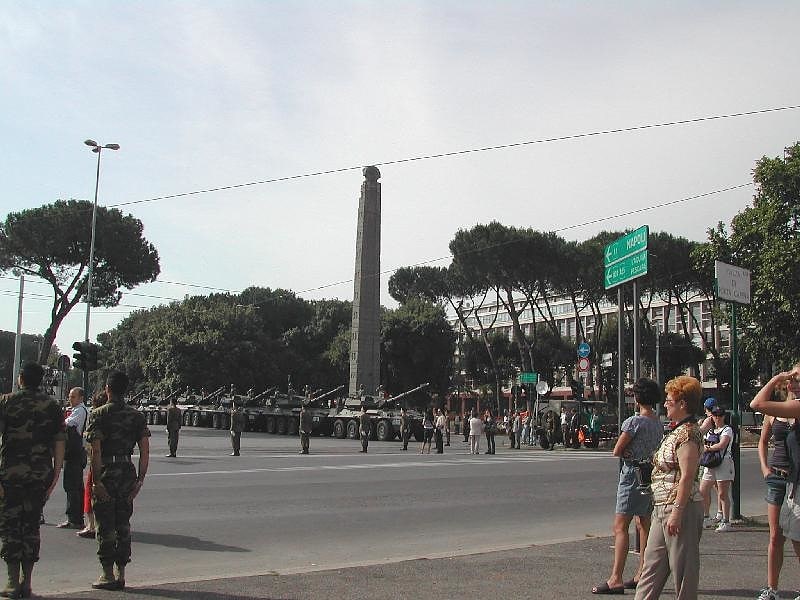
Also known as: የአክሱም ሐውልት
Historical landmark in Axum, Ethiopia. The Obelisk of Axum is a 4th-century CE, 24-metre tall phonolite stele, weighing 160 tonnes, in the city of Axum in Ethiopia. It is ornamented with two false doors at the base and features decorations resembling windows on all sides. The obelisk ends in a semi-circular top, which used to be enclosed by metal frames.[4]
King Ezana's Stele

King Ezana's Stele is an obelisk in the ancient city of Axum, in the Tigray Region of Ethiopia. The monument stands in the middle of the Northern Stelae Park, which contains hundreds of smaller and less decorated stelae. This stele is probably the last one erected and the largest of those that remain unbroken. King Ezana of Axum's Stele stands 21 m tall, smaller than the collapsed 33 m Great Stele and the better-known 24 m "Obelisk of Axum". It is decorated with a false door at its base and apertures resembling windows on all sides.[5]
Lioness of Gobedra
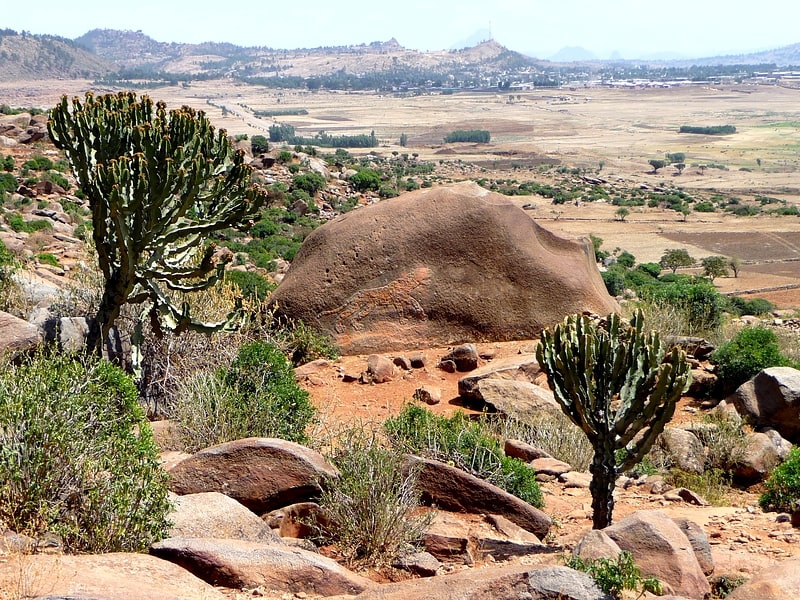
The Lioness of Gobedra is a rock sculpture located in Gobo Dura, Ethiopia. It is a representation of a crouching lioness around three metres long, which was carved into a relief on a large phonolite rock outcropping situated two kilometers west of Axum. It was first described by German archeologists in 1913.
The reason for this isolated stone carving is unknown, but the subject of much speculation. A local story, according to Philip Briggs, is that Archangel Michael was attacked by a lion here, and "he repelled the lion with such force it left an outline in the rock." Not far away is a quarry, where the stelae that adorn Axum are thought to have been carved, and there is a partially-carved example of one.[6]